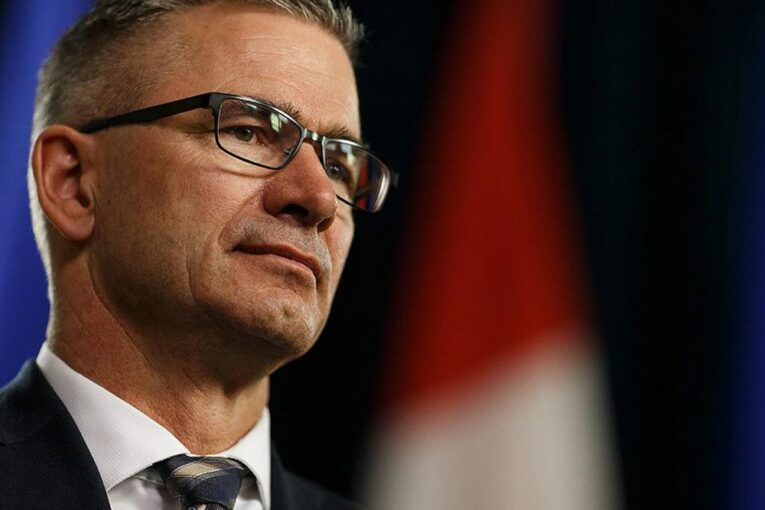
Alberta’s finance minister says the province is on track to balancing the budget using “cautious” assumptions on energy prices.
The province will end the year with a far smaller deficit than initially projected: $3.2 billion, and budget surpluses in each of the next three years — a massive reversal in fortune from only a year ago when the province was anticipating an $18-billion deficit in 2021-22.
“There’s no doubt that energy prices are playing a role and non-renewable resource revenues are a significant part of the revenue mix. It is true,” Travis Toews said in an interview following the release of a new budget Thursday. “But we’re also seeing significant strength in personal income tax revenues and corporate tax revenues.
“We’re using what I would suggest are very modest, cautious (assumptions) on energy prices … we’re not projecting balanced budgets on heyday oil prices.”
Still, Toews acknowledged that a windfall of revenue from resource royalties is helping the province balance the books for only the second time in more than a decade. Alberta is now forecasting surpluses over the next three years: $500 million in 2022-23, $900 million in fiscal 2024, and $700 million in fiscal 2025.
Total revenue is forecasted to reach $61.7 billion this year, a dramatic $18 billion upward swing from what was predicted in the depths of the pandemic last February — driven primarily by rising non-renewable resource revenues and income tax receipts as a result of increased employment and household income growth.
Analysts and economists say Alberta’s new fiscal outlook represents a “massive turnaround” in public finances.
“We had in 2020 an (actual) budget deficit that was on the order of $17 billion and this year, it looks like, based on where oil prices are and where they’re projected to be, the surplus could easily be $7 billion,” said University of Calgary economist Trevor Tombe.
“That change, however you measure it — per person, adjusted for inflation, share of the economy — it’s the largest swing in a provincial budget balance in (Alberta’s) history. Since 1905.”
While many economists had been expecting Alberta’s fiscal outlook to improve with oil prices climbing more than 20 per cent in 2022, the budget tabled on Feb. 24 in Alberta’s capital still raised eyebrows.
“I wasn’t surprised about the improvement, it’s the magnitude of the improvement,” said Dominique Lapointe, economist at Laurentian Bank.
“If you go back a year, just a year, (the deficit) was around $18 billion and now you’re in a surplus position. I think that’s the largest improvement I’ve seen across any province, where within a year you go from a large, structural, profound deficit, to a small surplus.”
The province is forecasting that Alberta’s economy will grow 5.4 per cent in 2022, and inflation-adjusted gross domestic product is expected to grow to $390 billion in 2025.
Non-renewable resource revenue is forecasted to reach $13.8 billion in 2022-23 — the second highest amount ever recorded, according to the government.
Total revenue is forecasted to reach $62.6 billion in 2022-23, climbing to $63.9 billion in fiscal 2025.
Toews pushed back at the suggestion that his government couldn’t take credit for balancing the books in a province where such a large share of revenue is closely tied to the price of oil.
“We’ve worked hard over the last three years to flatten our spending curve,” Toews said. “Even during the pandemic, even during COVID, when we had to depart from our fiscal plan that we presented to Albertans in 2019 … we never lost sight of our goal to carefully and thoughtfully bring our per-capita spending down to a line with similar provinces.
“To say that all of this was accomplished because of energy prices simply isn’t true. The facts do not bear out.”
Alberta is projecting oil prices to come down over the next couple of years and non-renewable resource revenues to drop, with the province forecasting West Texas Intermediate (WTI) oil price averaging US$70 per barrel in 2022-23, before settling around US$66.50 per barrel by 2024-25.
The province’s forecasts are indeed conservative, Tombe said. “Right now, where investors are buying and selling future deliveries of oil through this fiscal year it’s averaging $85 per barrel, so the government’s price assumption here is very conservative, relative to where the market is.”
Tombe said when it comes to balancing books in Alberta, some key factors that contribute to increased revenues are beyond the government’s control. But he added that the province’s UCP government could be credited with holding the line on spending: “Spending restraint was material under the government. That was something they chose to do and it did put them in a position to have a surplus this year.”
Still, economists say Alberta remains vulnerable so long as its finances continue to be reliant on volatile energy prices.
Lapointe said the reliance on oil royalties increases the volatility in budgetary results and makes long-term planning more difficult. He said he agrees with proposals floated by the Fraser Institute and others that would see the province invest a fixed percentage of non-renewable resource revenue in either the Alberta Heritage Trust Fund or a renewed Sustainability Fund.
“In good years you don’t really see the problem with the spending, but when oil prices collapsed, starting in 2015, then it really generated some sort of structural deficit,” Lapointe told the Financial Post.
“Either on the revenue side or on the spending side, there is still work needed to be done for the long-term stability of the province.”
• Email: [email protected] | Twitter: mpotkins
You can read more of the news on source
